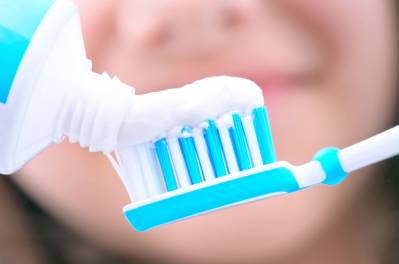Whitening your smile is as simple as visiting your dentist for a whitening treatment, or purchasing one of the lots of at-home treatment options available.
Using a bleaching tooth paste or mouthwash, attempting bleaching pens, strips or trays are all great ways to supplement your typical oral health habits.
In Crest 3D
Active ingredient: Sodium fluoride 0.243% (0.16% w/v fluoride ion)
Inactive ingredients: glycerin, hydrated silica, sodium hexametaphosphate, water, PEG-6, flavor, trisodium phosphate, sodium lauryl sulfate, carrageenan, cocamidopropyl betaine, sodium saccharin, sucralose, xanthan gum, titanium dioxide, mica.
In AP24
Active Ingredient: Sodium Monofluorophosphate 0.76% (0.15% w/v fluoride ion)
Inactive Ingredients: Water (Aqua), Hydrated Silica, Sorbitol, Alumina, Glycerin, Tetrasodium Pyrophosphate, PEG-12, Dimethicone 1 , Poloxamer 338 1 , Poloxamer 407 1 , Cellulose Gum, Sodium Lauryl Sulfate, Flavor (Aroma), Sodium Saccharin, Titanium Dioxide (CI 77891).
In Colgate Total Advanced
Active Ingredients: Sodium fluoride 0.24% (0.15% w/v fluoride ion), Triclosan 0.30%
Inactive Ingredients: water, hydrated silica, glycerin, sorbitol, PVM/MA copolymer, sodium lauryl sulfate, flavor, cellulose gum, sodium hydroxide, propylene glycol, carrageenan, sodium saccharin, titanium dioxide.
In Arm & Hammer Advance White Extreme
Active ingredient: Sodium Fluoride 0.24% – Anticavity toothpaste.
Inactive ingredients: Sodium Bicarbonate (Baking Soda), PEG-8, PEG/PPG-116/66 Copolymer, Sodium Carbonate Peroxide, Tetrasodium Pyrophosphate, Silica, Sodium Saccharin, Flavor, Water, Sodium Lauryl Sulfate, Sodium Lauroyl Sarcosinate.
In Sensodyne Extra Whitening Toothpaste
Active ingredient: Potassium nitrate, sodium fluoride
Inactive ingredients: Water; Hydrated Silica; Sorbitol; Glycerin; Pentasodium Triphosphate; PEG-8; Flavor; Titanium Dioxide; Cocamidopropyl Betaine; Sodium Methyl Cocoyl Taurate; Xanthan Gum; Sodium Hydroxide; Sodium Saccharin; Sucralose.
In Aquafresh Extreme Clean
Active ingredient: Sodium fluoride (0.15% w/v fluoride ion)
Inactive ingredients: water, hydrated silica, sorbitol, glycerin, PEG-8, flavor, sodium lauryl sulfate, xanthan gum, titanium dioxide, cocamidopropyl betaine, sodium saccharin, synthetic iron oxide, red 30.
What Is the Whitening Ingredient in Toothpaste?
Whitening is any process that will make teeth appear whiter. A product can whiten the tooth, which means that it in fact changes the natural tooth color. Whitening items consist of peroxide(s) that assist remove deep (intrinsic) and surface area (extrinsic) stains.
Sensitive Teeth After Teeth Whitening
Sometimes after whitening treatments, teeth can be sensitive. If this happens you have options to minimize the pain.
- Use a sensitivity tooth paste – sensitive toothpastes are developed with active ingredients such as potassium nitrate to alleviate the pain connected with tooth level of sensitivity
- Chew gum – researchers have found that more saliva is produced when chewing gum. And the act of chewing might sidetrack individuals from the pain.
- Prevent bleaching for a while – give your teeth a break and stop utilizing whitening items.
Even if you follow near-perfect dental health, you can still end up with yellow teeth. Your age, the foods you eat and your lifestyle habits can all add to discolorations and yellowed teeth that aren’t precisely picture-perfect. Obviously, thanks to the availability of whitening tooth paste, you do not necessarily need to see your dentist to restore your gleaming white smile. However before you get a tooth paste that guarantees to whiten your teeth, make certain you understand the hows and whys so you can choose the right product.
How Do Whitening Ingredients Work?
While there countless choices offered on pharmacy racks, not all whitening toothpastes are created similarly. It’s the active ingredients that make the real difference in how successfully the products whiten. Normally, tooth pastes include one of three whitening components:
- Mild abrasives. Inning accordance with the American Dental Association (ADA), some toothpastes contain mild abrasives that consist of active ingredients such as magnesium carbonate, hydrated aluminum oxides and calcium carbonate. Abrasives can get rid of surface spots that might cause yellowing in order to expose a whiter, brighter smile.
- Hydrogen peroxide. A low-dose variation of hydrogen peroxide has a recognized bleaching effect on teeth and is the active component in the majority of whitening systems used in dental experts’ offices. While the concentration in whitening toothpastes is less than the quantity in single-use products, hydrogen peroxide can produce exceptional outcomes (and is safe to use) over a longer period. The ADA notes that bleaching agents, such as hydrogen peroxide, can cause moderate sensitivity however are still safe and approved for regular use.
- Carbamide peroxide. Carbamide peroxide is essentially a whitening agent that breaks down into hydrogen peroxide. The main benefit of carbamide peroxide is that, according to a research study published in the September 2000 problem of the Journal of the American Dental Association, carbamide peroxide produced results quicker than hydrogen peroxide in the first 2 Week of the study. However, results between carbamide and hydrogen peroxide were comparable after 12 weeks of use.
Daily Usage
So long as bleaching items are suggested for daily use, you can use them daily. These consist of such products as the line of tooth brushes, toothpastes and mouthrinse. Some people might experience sensitivity when using products that contain hydrogen peroxide. You can relieve sensitivity by alternating the bleaching tooth paste with a regular or delicate toothpaste every day.
How Long Does It Require to Whiten?
The period of time it considers an item to whiten your teeth depends significantly on the ingredients and the function of the tooth paste. If, for instance, you use a new toothpaste , which includes hydrogen peroxide, you’ll see outcomes much more rapidly than if you use a whitening toothpaste which contains only surface-stain removers.
Whitening your smile with day-to-day brushing makes good sense. You’re brushing anyway, so you might also whiten your teeth, too.
References: dailymed.nlm.nih.gov/






